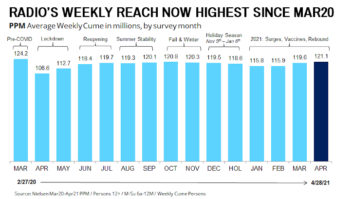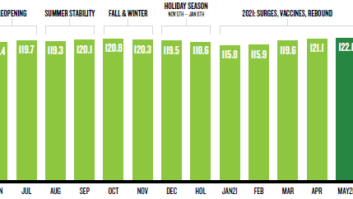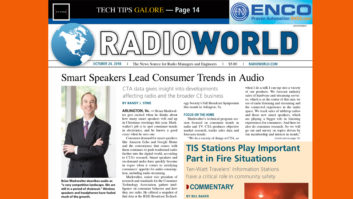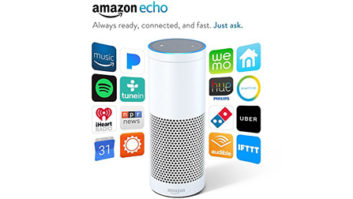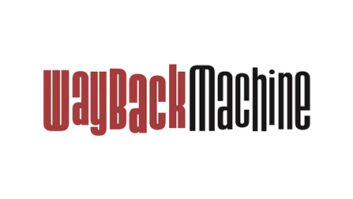This holiday season, Internet connectivity is a growing trend and AM/FM and HD Radio remain in the dash among a proliferating number of audio entertainment choices in new car dashboards. Personal music services like Pandora continue to make gains via in-car streaming using connected smartphones. Automakers have sent new cars into dealerships with larger entertainment screens and varied apps controlled by smartphone.
HD Radio’s first data-only device is hitting store shelves, and iBiquity Digital and the HD Radio Alliance have holiday promotions underway. Work continues on HD chip integration into cellphones and other devices and closing the back-channel loop so consumers can interact with their devices as well as with stations and advertisers.
Observers disagree on how much consumers will spend for consumer electronics this holiday season. Without releasing exact figures, NPD in October said its research leading into the holiday shopping season indicates more traffic will come to stores, though that may be at the expense of online business. As retailers run more promotions and put more products on sale, NPD predicts, consumers won’t spend more but differently, looking to get the best price regardless of location.
In contrast, the International Council of Shopping Centers predicts retail sales for November and December 2011 combined will rise 3.5 percent compared to the same period a year ago. That compares with 2010, when sales were up 4.4 percent, in what industry analysts called the best holiday results since 2006.

CUE — ‘Cadillac User Experience’ — will pair entertainment and information data from up to 10 Bluetooth-enabled mobile devices, USBs, SD cards and MP3 players with a vehicle infotainment system. The system includes AM/FM, HD Radio and XM Satellite Radio.
Despite low consumer confidence in the economy and unemployment figures steady at a median of more than 9 percent, the council expects months of solid sales to carry through to the end of the year.
Three years after the recession-haunted 2008 holiday season, retailers have become savvier about not being stuck with too much unsold inventory and keeping prices budget-friendly, according to the ICSC.
IBiquity Digital Senior Vice President of Marketing Stephen Baldacci agrees, saying consumer electronic brands “are trying to make sure their barns are empty before CES. There’s not a lot [of product] being introduced now so they’re not left with unsold inventory.”
Listening with smartphones
Regarding radio consumption in the car, eight in 10 consumers say they listened to the radio while in their vehicle during the previous three months, according to an NPD survey released in October. That’s down two percentage points from last year.
Nearly a third (29 percent) of survey respondents said they used a smart device — including the iPod touch, iPhone or Android smartphone — an increase of nine percentage points since last year. The 3.5 hours per week consumers spent listening to music on smartphones also rose 9 percent compared to a year-ago. The findings are based on about 10,000 surveys of respondents age 13 and older.
A tipping point is approaching as vehicles and portable devices move from a tethered connection to a more integrated connection, according to NPD Entertainment Analyst Russ Crupnick.
“Smart devices streaming music could end up being the largest threat to CDs and broadcast radio since the dawn of digital music.”
While not voicing so dire a prediction, Livio Radio Founder and CEO Jake Sigal agrees that a number of consumers are looking to have smartphone capability built into the dash or some way to connect them to the dash so they can use the devices in their vehicles.
Consumers change phones “faster than cars,” he said. “The big thing at retail now is app-powered devices that control an app from an accessory while the phone is in your purse or pocket.”

Livio Bluetooth Internet Radio Car Kit is a plug-and-play gadget that brings Internet radio and music from a listener’s iPod or iPhone to any FM car stereo.
That’s why his company released the Livio Bluetooth Internet Radio Car Kit, a plug-and-play gadget that brings Internet radio and music from a listener’s iPod or iPhone to any FM car stereo. The kit also offers Bluetooth hands-free calling, USB charging and buttons to control the Livio Car Internet Radio application.
A forecast from the Consumer Electronics Association supports an expectation of growth in Internet-capable car radios, meaning Internet radios that work with a smartphone adapter. CEA predicts such in-car stereo system sales will increase 83 percent over the next two years. It projects 410,000 aftermarket car radio systems with Web capabilities will be sold this year, with that figure growing to 749,000 by 2013.
Alpine, Pioneer, JVC, Kenwood and Sony have expanded the number of aftermarket radios that offer Pandora control with apps on USB-connected smartphones. Clarion, Pandora’s newest and sixth aftermarket supplier, unveiled a Pandora-ready headunit in November. The manufacturer said the CD source unit, the CZ202, would be available during the holidays.
Another example is Pioneer’s AppRadio, featuring a six-inch touchscreen display that when used along with the unit’s advanced app mode facilitates the use of a connected iPhone 4’s applications from Pioneer and other providers in the car. In addition to functions like AM/FM radio and Bluetooth hands-free calling, when an iPhone 4 is connected the user will have access to music, photos, Google maps, iTunes apps and (when the car is parked) Internet streamed video.
Today’s drivers
Many of these aftermarket units that control Pandora with an app and USB-connected smartphone receive HD Radio stations as well.
Buick’s IntelliLink system with Pandora will be available later this year. Pandora also says its personalized music service is available in some 2012 Chevy, Ford, Hyundai, Toyota, Scion, Mini and BMW models that offer connectivity in the car.
Automakers believe adding the ability for drivers to hear personalized music from several devices in the car is what drivers want.
“About 70 percent of all new car buyers want some form of connectivity,” said a GM executive director, Micky Bly, earlier this year.
Respondents to a Harman survey released in November showed most car commuters want Internet radio in the vehicle (64 percent), a navigation system that provides real-time traffic updates (83 percent) and voice control of their car’s infotainment systems (80 percent).
Consumers “want their car to be a place where they can stay productive and informed and not be forced to break away from a busy day,” according to Harman, which said 500 people took part in the October survey.

In addition to the basic functions like AM/FM radio and Bluetooth hands-free calling, when an iPhone 4 is connected to Pioneer’s AppRadio, the user will have access to music, photos, Google maps, iTunes apps and (when the car is parked) Internet streamed video.
About 19 percent of respondents this summer told Arbitron, Edison Research and Scarborough they listen to Internet radio in the car; the bulk of those listeners were 18–24 years old, a prime demo for aftermarket radios.
Responding to demand from customers, Ford Sync, and Toyota Entune offer multi-featured multimedia systems that feature AM/FM, HD Radio, satellite radio and the ability to stream iHeartRadio, Pandora or other Internet personalized music systems via a connected smartphone. The first cars with iHeartRadio were showing up on Toyota lots in November as part of the Entune system, according to both companies.
Cadillac is the latest to offer connectivity with its recently-announced CUE system for certain models in 2012.
CUE, which stands for Cadillac User Experience, will pair entertainment and information data from up to 10 Bluetooth-enabled mobile devices, USBs, SD cards and MP3 players with a vehicle infotainment system that the automaker promises will reduce complexity through customized information, natural voice commands, fewer buttons and larger icons. The system includes AM/FM, HD Radio and XM Satellite Radio. Users will be able to stream Pandora to their dash via a connected smartphone.
These new vehicle entertainment systems are visually oriented, aiming to serve drivers without distracting them.
Visual interaction is why iBiquity Digital and the HD Radio Alliance are encouraging stations to implement the advanced data capabilities of digital radio. FM HD stations, they say, should sport a user interface similar to what young people see on personalized music and Internet radio services.
The alliance has a task group headed by CBS Radio Senior Vice President Engineering Glynn Walden and Emmis Senior Vice President/Chief Technology Officer Paul Brenner to get station managers on the same page with engineers about implementing so-called Artist Experience, which syncs audio with visual elements, at their stations. While station executives may believe their radio groups support AE now, the experience of actually implementing advanced data applications for HD Radio at the station level in many cases is different. The group is surveying member stations to determine which ones have implemented the power increase and other HD data capabilities needed to support AE and which ones need help, according to Brenner.
Garmin PND
Clear Channel has implemented the capability in several markets. Greater Media plans to implement AE on the bulk of its stations in the New Year, it recently told Radio World.
Beasley Broadcast plans to also make its commercial messages visual on several digital stations in the New Year, calling the tech the “Advertiser Experience,” a play on iBiquity’s Digital’s Artist Experience. Generally the number of HD stations implementing AE has been small, with Clear Channel beta testing AE in 18 markets.
Emmis President/CEO Jeff Smulyan credits the new HD Radio smartphone app being developed by Emmis Interactive, iBiquity and Intel, with support from NAB’s FASTROAD technology project — as innovative.
Forty-one models of cellphones on the market have enabled FM chips, according to CTIA, The Wireless Association. Along with the radio industry’s efforts to integrate HD Radio chips into cellphones, the app provides a back channel so consumers listening to a station can interact with the station or its advertisers. Smulyan said on an earnings call recently that the app “has a chance to be truly transformative to our industry.”
Brenner of Emmis also is president of the Broadcast Traffic Consortium, which has about 25 participating radio groups. NAVTEQ is their customer, supplying traffic information via analog FM RDS and FM HD Radio signals, to Garmin, for example.
The Garmin NUVI 3490 LMT is now at stores. It’s the first Garmin personal navigation device that uses HD Radio data only and is not also a receiver. The digital data pipe can transport more data at a faster pace than analog FM, say iBiquity and the BTC; so the unit can provide faster updates and more detailed overage of alternative routes around an accident. Updates are made every 30 seconds, as much as 10 times fasterthan traditional traffic receivers, according to Garmin.
Garmin HD Digital Traffic also will be available as an upgrade to other Garmin products through an adapter.
Ibiquity is working with Garmin on promotion; Baldacci expects wide distribution for the product, including placement on the Crutchfield catalog cover.
“We’re working with Garmin and retailers on why HD Radio traffic is better and different than traditional traffic services.”
Aftermarket car stereo retailers with “assisted sales floors” tell iBiquity that “up-selling” customers $20 to $30 for an HD Radio model can happen easily, he said. “Their experience with HD is positive. That’s good for a retailer.”
He used an example of a $20 up-sell on a $110 car stereo to $130, producing some 18 percent higher revenue.
“There are two ways retailers measure performance: gross margin and average revenue per sale. Getting $20 to $30 more for the same sales effort is worth it,” said Baldacci.
Finally, Sirius XM released its 2.0 service; the new platform features additional channels and data bandwidth. It introduced the SiriusXM Edge, the first satellite radio able to receive the expanded programming lineup, in October. It hoped a plug-and-play tuner, Lynx 2.0, featuring WiFi and Bluetooth, would be available by the end of the year.






